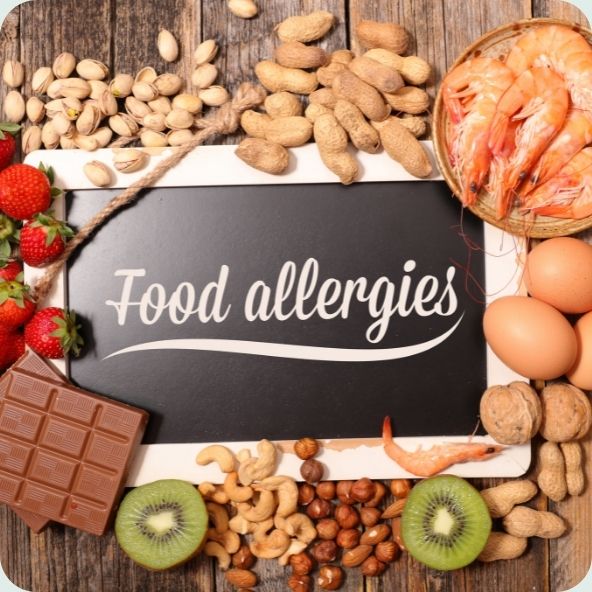 Awareness of food-related health issues in children has grown significantly over recent years. Parents and caregivers in the UK and worldwide are becoming increasingly vigilant about the foods their children consume. Two common concerns are paediatric food allergies and food intolerances, often confused but distinct conditions. Understanding the difference between them is crucial for effective management and ensuring the health and well-being of children.
Awareness of food-related health issues in children has grown significantly over recent years. Parents and caregivers in the UK and worldwide are becoming increasingly vigilant about the foods their children consume. Two common concerns are paediatric food allergies and food intolerances, often confused but distinct conditions. Understanding the difference between them is crucial for effective management and ensuring the health and well-being of children.
Paediatric Food Allergy
A paediatric food allergy involves the immune system’s abnormal response to certain foods. When a child with a food allergy consumes the offending food, their body misinterprets it and produces substances such as histamine in an attempt to combat it. A wide range of symptoms, from minor to severe and perhaps life-threatening, can be brought on by this immunological reaction.
Symptoms of Food Allergies
- Mild to Moderate Symptoms: Hives, itching, eczema, swelling of the lips, face, and eyes, stomach pain, vomiting, and diarrhoea.
- Severe Symptoms (Anaphylaxis): Difficulty breathing, swelling of the throat, a sudden drop in blood pressure, rapid pulse, dizziness, and loss of consciousness. Anaphylaxis is a medical emergency that requires immediate attention.
Common Allergens
In the UK, children’s most common food allergens include cow’s milk, eggs, peanuts, tree nuts, soy, wheat, fish, and shellfish. According to the NHS, around 5-8% of children in the UK have a food allergy, with many outgrowing certain allergies, such as milk and egg allergies, by the age of five.
Diagnosis and Management
Diagnosis typically involves a combination of medical history, skin prick tests, blood tests, and supervised food challenges. Management focuses on strict avoidance of the allergen and emergency preparedness. Families are often advised to keep antihistamines and adrenaline auto-injectors (such as EpiPens) readily available.
Paediatric Food Intolerance
In contrast to food allergies, food intolerance does not involve the immune system. Instead, it occurs when a child’s digestive system cannot properly break down certain foods. While food intolerance can cause discomfort and affect quality of life, it is not life-threatening.
Symptoms of Food Intolerance
- Digestive Symptoms: Bloating, stomach pain, diarrhoea, gas, and nausea.
- Other Symptoms: Headaches, fatigue, and joint pain in some cases.
Common Intolerances
The most prevalent is lactose intolerance, which occurs when the body is unable to break down the lactose present in dairy products due to a deficiency of the enzyme lactase. Other intolerances may include reactions to gluten (non-coeliac gluten sensitivity), food additives, and certain natural food chemicals like salicylates.
Diagnosis and Management
A more difficult diagnosis may entail gradually reintroducing suspected foods after an exclusion diet has been followed in order to pinpoint the offending meal. Breath tests for lactose intolerance and hydrogen breath tests for other carbohydrate malabsorptions are also used. Management usually involves dietary adjustments to avoid or limit the intake of problematic foods.
Key Differences
- Immune System Involvement: Food allergies involve an immune response, while food intolerances do not.
- Severity: Allergies can cause severe, life-threatening reactions, whereas intolerances typically result in uncomfortable but non-life-threatening symptoms.
- Diagnosis: Allergies are diagnosed through specific tests like skin prick and blood tests, whereas intolerances often require elimination diets and symptom monitoring.
- Management: Allergies require strict avoidance of the allergen and emergency plans for accidental exposure, while intolerances are managed through dietary modifications.
Prevalence and Impact in the UK
In the UK, food allergies are a significant public health concern, affecting an estimated 1 in 12 children, with a higher prevalence in those with a family history of allergies or other atopic conditions like asthma and eczema. Food intolerances are also common but often underreported due to less severe symptoms and difficulty in diagnosis.
Schools and childcare providers in the UK increasingly accommodate children with food allergies and intolerances by implementing policies to ensure safe environments. This includes training staff to recognise and respond to allergic reactions and offering alternative meal options to accommodate various dietary needs.
Conclusion
Understanding the difference between paediatric food allergy and food intolerance is essential for parents, caregivers, and educators. While both conditions require careful management, recognising the distinct nature of each can lead to better health outcomes and improved quality of life for affected children. In the UK, continued research and public awareness are vital in addressing these conditions and supporting families in managing their children’s dietary needs safely and effectively.
